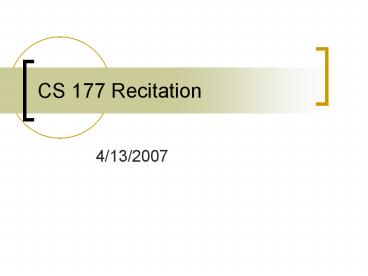CS 177 Recitation - PowerPoint PPT Presentation
1 / 14
Title: CS 177 Recitation
1
CS 177 Recitation
- 4/13/2007
2
Reminders
- Lab Evaluations will be next week.
- Recitation Evaluations in 2 weeks.
- Project 5 Due on 4/18.
3
Review
- What are the three parts of the von Neumann
architecture? - CPU
- Memory
- I/O
- What was the main advance?
- Storage of programs in main memory.
4
The CPU
- What are the three main parts of the CPU?
- ALU (Arithmetic Logic Unit)
- Control Unit
- Registers
- How are they all connected?
- Bus how the data in a computer is transferred
from one place to another.
5
The Parts
- ALU
- Is where all of the operations like add,
subtract, AND, OR, etc. are performed. - Control Unit
- Tells data where to go
- Deciphers the machine language
- Runs the fetch-execute cycle
- Registers
- Hold data in the processor
- Very fast access
6
How does it work together?
- The movement of data that is coordinated by the
Control Unit is called the datapath. - It always starts at the registers, goes to the
ALU for computation, then is stored in the
registers again.
7
Knobs and Switches
Click here to launch the datapath simulator.
8
Assembly Language
- Direct translation of Machine Language with 2
differences - Instead of 1s and 0s, assemble language uses
abbreviations, such as ADD, SUB, MUL, DIV, LOAD,
etc. - Also can use labels and variables, which do not
occur in machine language.
9
Assembly vs. Machine
10
Knobs and Switches and more
Click here to launch the datapath with memory
simulator.
11
More about the Control Unit
- The Control Unit fetches each machine language
instruction from memory, interprets its meaning,
carries out the specified CPU cycle, and then
moves on to the next instruction - This is called the Fetch-Execute cycle
12
A sample program
- What does this do?
13
Knobs and Switches the finale
Click here to launch the complete simulator.
14
Questions?































